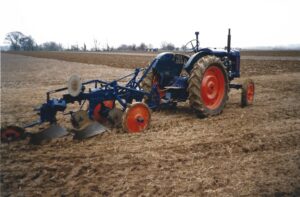Henry Brown’s Vintage -The Fordson Major
21st May 2021
A look back at the manufacturing history of the Fordson Major, made from 1917-1951.

The first Model F Fordson tractors were made at Dearborn in America in 1917; it was superseded by the Model N in 1929. Tractor production was transferred to Dagenham in 1933, and many thousands of Model N tractors had been built when its successor, the E27N Fordson Major, appeared in 1945.
The letter E was for England and 27N denoted the tractor as a 27hp version of the earlier Model N. It was available with the same gasoline or vaporising oil side-valve engine as the earlier Model N with splash feed lubrication, magneto ignition and a starting handle along with a three forward and one reverse gearbox. However, the Fordson Major had a new transmission with a single plate clutch, crown wheel, dierential and spur gear final drive.
The standard tractor had a top speed of 4.17mph, a high speed model with a speed of 7.48mph in top gear was also available. Standard, Agricultural Rowcrop, Land Utility and Industrial versions of the E27N were all built at Dagenham. The Standard and Agricultural Rowcrop models had steel wheels, steering brakes, adjustable wheel track and a swinging drawbar.
Electric starting, a side mounted belt pulley and hydraulic linkage were among the optional extras and pneumatic tyres were added to the list in 1946. The Land Utility model was added to the range in 1946; rubber tyres were standard but it did not have steering brakes or adjustable wheel track settings. The Industrial model with an optional Perkins P6 diesel engine appeared in 1948.
The Ford Motor Co bought a factory and iron foundry at Leamington Spa in 1945 to manufacture implements for the E27N Fordson Major. Implements made there included two-and three-furrow trailed Fordson Elite ploughs with Ransomes bodies, a cultivator and a ridger.
The last E27N tractors were made in 1951, and the 40hp the New Fordson Major E1A was launched at that year’s Royal Smithfield Show.
